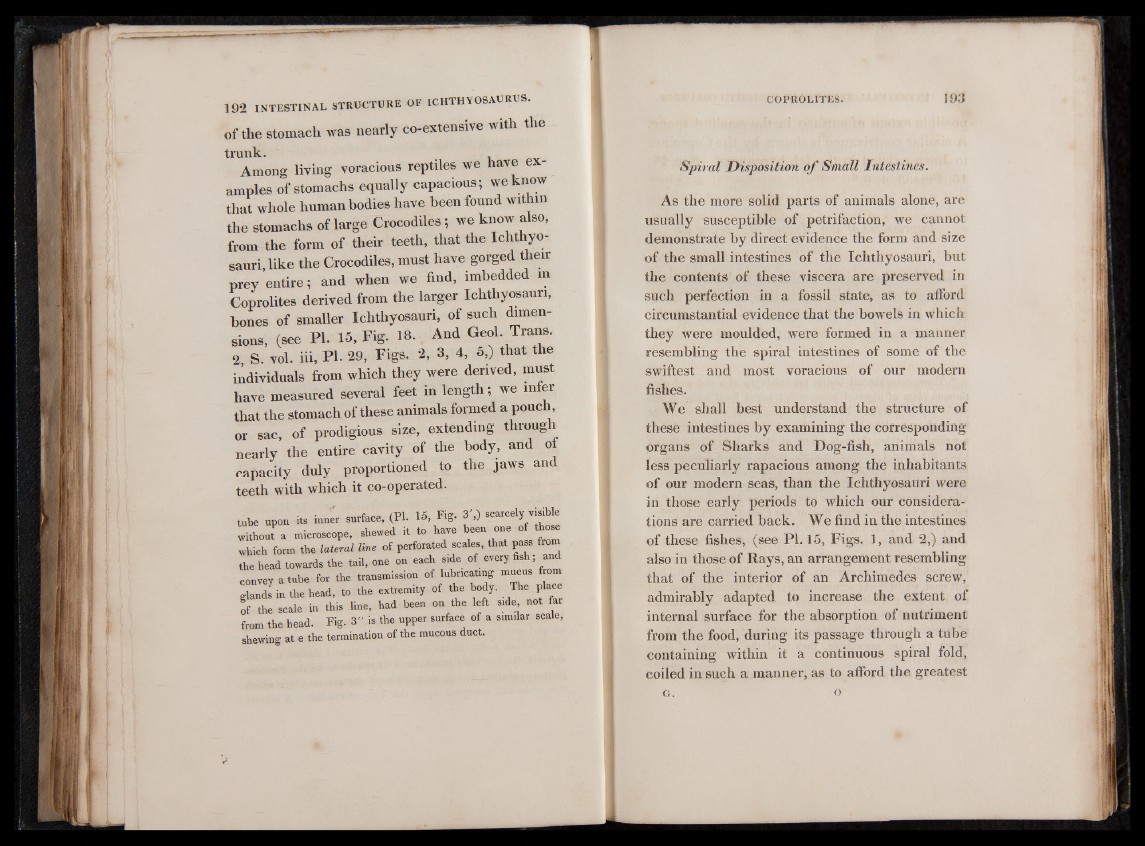
of the stomach was nearly co-extensive with the
trunk
Among living voracious reptiles we have examples
of stomachs equally capacious; we know
that whole human bodies have been found within
the stomachs of large Crocodiles; we know also,
from the form of their teeth, that the Icht yo-
sauri, like the Crocodiles, must have gorged their
prey entire; and when we find, imbedded in
Coprolites derived from the larger Ichthyosauri,
bones of smaller Ichthyosauri, of such dimensions,
(see PI. 15, Fig. 18. And Geol.
2, S. vol. iii, PI. 29, Figs. 2, 3, 4, 5,) that the
individuals from which they were derived, must
have measured several feet in length; we infer
that the stomach of these animals formed a pouch ,
or sac, of prodigious size, extending through
nearly the entire cavity of the body, and of
capacity duly proportioned to the jaws and
teeth with which it co-operated.
tube upon it, inner surface, (PL 15, Fig. 3',) scarcely visible
wthout a microscope, shewed it to have been one of those
which form the lateral line of perforated scales, that
the head towards the tail, one on each side of every fish, and
convey a tube for the transmission of lubricating mucus from
glands in the head, to the extremity of the body. The Pla“
of the scale in this line, had been on the left side not far
from the head. Fig- 3" is the upper surface of a similar scale,
shewing at e the termination of the mucous duct.
Spiral Disposition o f Small Intestines.
As the more solid parts of animals alone, are
usually susceptible of petrifaction, we cannot
demonstrate by direct evidence the form and size
of the small intestines of the Ichthyosauri, but
the contents of these viscera are preserved in
such perfection in a fossil state, as to afford
circumstantial evidence that the bowels in which
they were moulded, were formed in a manner
resembling the spiral intestines of some of the
swiftest and most voracious of our modern
fishes.
We shall best understand the structure of
these intestines by examining the corresponding
organs of Sharks and Dog-fish, animals not
less peculiarly rapacious among the inhabitants
of our modem seas, than the Ichthyosauri were
in those early periods to which our considerations
are carried back. We find in the intestines
of these fishes, (see PI. 15, Figs. 1, and 2,) and
also in those of Rays, an arrangement resembling
that of the interior of an Archimedes screw,
admirably adapted to increase the extent of
internal surface for the absorption of nutriment
from the food, during its passage through a tube
containing within it a continuous spiral fold,
coiled in such a manner, as to afford the greatest
G. o